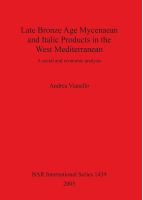Description
BOOK DESCRIPTIONAegean-type pottery has been found in the West Mediterranean for more than a century and several publications have tried to explain the phenomenon from an Aegeancentric point of view. The search for metals, the arrival of Mycenaean people after the LH III B destructions in Mainland Greece and the hypothesis that Mycenaeans had to sail westwards because of the dominance of the Minoan thalassocracy on the eastern routes are only some of the proposals. Yet, what do we know about the Italics, the people who consumed, and eventually produced, Aegean-type pottery? This question is at the centre of this study. The state of research on this topic, in spite of almost a century and a half of studies is disappointing. The phenomenon is still seen in terms of economic exchange, where the Aegeans are the primary players. There has been no attempt to research methodically the reasons why the Italics accepted and used Aegean-type pottery. In the last few decades, many anthropologists have concentrated their efforts on ethnographic studies of patterns of consumption and several theoretical models have been published as a result. In particular, globalisation has provided the stimulus for research focussed on cross-cultural consumption of standardised products. Using these studies, this research has tried to provide the Italic perspective, one of consumption as well as production. The results of this research demonstrate the independence of the Italics in their choices as consumers and provide insights on the social and cultural processes of these Bronze Age populations. As a result, while the role of the Aegeans in the phenomenon appears less important, the complexity of the regional Italic processes associated with the presence of Aegean-type pottery in the West Mediterranean becomes more apparent.











